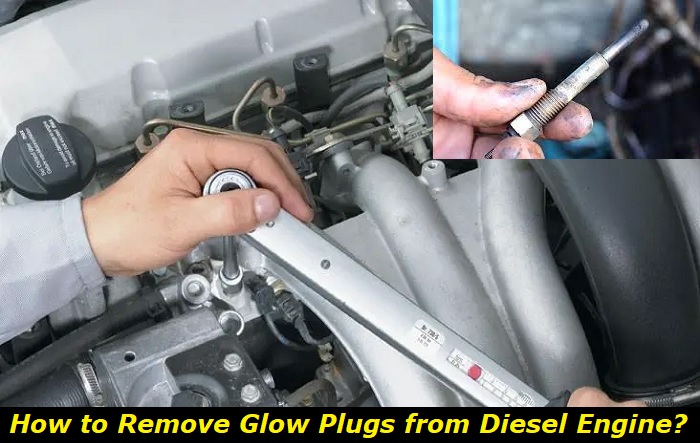Glow plugs, or heater plugs for some, are responsible for providing the spark that allows your car's diesel engine to start. Without them, it will be difficult to get your car up and running, especially during the cold winter months.
Engine repair mistakes highlights
- Level of importance:extremely important
- When done:DIY repairs or diagnostics
- Cost of mistake:$250 - $4,000
- How to avoid:professional inspections, getting help from mechanics
- Consequences:broken engine, need for engine replacement
- DIY solutions:not many

How To Replace Glow Plugs?
Because of the nature of their work, the rate at which glow plugs deteriorate stems mainly from where you live. Normally, glow plugs can last up to 100,000 miles before needing replacement. However, that's not the case in colder climates.
Diesel engines tend to require more time when starting in cold weather. As a result, glow plugs will work harder and go through more significant wear and tear than their counterparts in warm areas.
That's not to say that there are no risks to firing a diesel engine in warm climates. If the temperature outside is far hotter than normal, it can cause the glow plugs to overheat and break internally.
Don't worry though, since replacing a car's glow plugs is quite a simple and easy task, just as long as you follow the steps below. Whether you live in a cold or warm region, these steps will surely make replacing glow plugs an easy task to do.
1) Prepare The Necessary Equipment/Materials
First, make sure to gather and prepare all the pieces of equipment and materials that you will need for this project. Doing this allows you to save time in the long run and makes the whole process much easier to do. Below are all the things that you will need when replacing glow plugs:
- Safety Gloves
- Face Mask
- Replacement Glow Plugs
- Pliers
- Replacement Cover Gasket
- Deep Socket Set
- Ratchet
- Screwdriver
- Wire Brush
- Multimeter
- Pen
- Notebook
2) Disconnect The Battery Cable
When working on any vehicle's electrical system, always remember to disconnect the battery cable. This is to prevent mishaps and accidents from occurring as you work.
Also, keep a pen and a piece of paper nearby. Take notes of which parts you removed while doing the repairs so you have an idea of where each one goes later at the end.
3) Remove The Valve Cover
Next, you need to locate where the glow plugs are. Sometimes, you need to remove several valve covers to get to the glow plugs. But if the glow plugs are visible, you can skip this step.
With the use of a screwdriver, undo the screws around the perimeter of the valve covers. Be careful not to let the valve cover gasket in between fall out. Also, keep the screws in a safe place so as not to lose them.
Additionally, this is also a good time to check the condition of these valve cover gaskets. Replace them if necessary.
4) Detach The Glow Plugs
The next step is to detach the glow plugs. Before you can do that, though, use a pair of pliers to carefully disconnect the glow plugs from the terminal.
Afterward, use the socket and ratchet to detach the glow plugs. When pulling out the glow plugs, pay attention to any leftover broken pieces.
Glow plugs can sometimes break within their respective compartments. When that happens, you will need to remove every last piece before attempting to replace them.
5) Install The New Glow Plugs
After pulling out the old glow plugs, it's time to install the replacement glow plugs. But first, you need to make sure that the compartments are clean and free from any dirt and grime. Use a wire brush to help you clean out each compartment.
Once done, carefully install the new glow plugs. Use the socket and ratchet to gently tighten each one into place. Do not overdo this step to avoid breaking the glow plugs upon installation.
6) Reconnect The Cables
After installing the replacement glow plugs, it's time to put everything back together. Up to this point, make sure you keep all the screws and similar parts together in batches, depending on where they were initially.
Reconnect the cables to allow power to course through the car's electrical systems once more. To check whether or not the repair is a success, use a multimeter.
What Are the Usual Suspects When It Comes to Faulty Glow Plugs?
When it comes to heater plug failure, there are a few reasons why. The first and most obvious factor is the climate where you live. Extreme temperatures are a common reason why a car's glow plugs often fail.
Besides that, there are a few others. One example is high voltage. This can cause glow plugs to overheat and break within their compartments.
Another reason is using the wrong set of glow plugs for your car's diesel engine. So when buying a replacement set, always check to make sure that what you're buying is compatible with your respective car model.
Damaged pistons and broken valves are two other reasons that can cause glow plug failure. If one or both are not working, then your car's glow plug will not function at all since there's not enough power present.
Are Spark Plugs and Glow Plugs the Same?
For those wondering if glow plugs and spark plugs are the same things, the answer is both yes and no. Confused? Worry not.
Spark plugs are for gasoline engines. Since gasoline is more combustible than diesel, a simple spark is all that you will ever need when firing a gasoline engine.
Whereas a diesel engine requires more than just a spark, especially in cold climates. Diesel begins to gel once temperatures go below 40 degrees Fahrenheit. As such, glow plugs are a necessary component for any diesel engine.
Do All Diesel Engines Require a Glow Plug?
While all glow plugs come with a diesel engine, the opposite isn't quite true. That's because there are plenty of diesel vehicles that run without the help of glow plugs. The only catch, though, is that these vehicles are not for public or consumer use.
Diesel vehicles that don't use glow plugs often use another process when firing the engine. That process is called adiabatic compression. Most diesel vehicles that use this process when firing the engine are often military vehicles or older car models that are not in production anymore.
Modern diesel vehicles nowadays make use of glow plugs. They help make starting a cold engine much easier after all.
Can a Diesel Engine Run with a Faulty Glow Plug?
In some cases, you can still fire up your car's diesel engine even if the glow plug is not working. Even a faulty glow plug can still produce enough heat to help start the engine, although, this will take longer than usual.
Also, repeatedly doing this will not be good for your car's engine. You can flood the engine with too much fuel. When that happens, it can cause the car's engine to stall and incur internal damages.
Conclusion
Glow plugs help make starting a modern diesel engine an easy task. So when even one is not working, this can cause problems down the line. It becomes more apparent the more powerful a diesel engine is.
However, replacing them is quite easy. And it won't break your bank, either. There are plenty of drivers that carry a set of glow plugs in the trunk of their car in case one or more start failing and firing the engine becomes a difficult task.
The longer you delay replacing glow plugs, the more problematic it will be for you. So if you're having any difficulties when it comes to firing your car's diesel engine, make sure to check the glow plugs to see if they're in good working condition. Or always set an appointment with your local auto shop once it's nearing the time to replace your car's glow plugs.
About the authors
The CarAraC research team is composed of seasoned auto mechanics and automotive industry professionals, including individuals with advanced degrees and certifications in their field. Our team members boast prestigious credentials, reflecting their extensive knowledge and skills. These qualifications include: IMI: Institute of the Motor Industry, ASE-Certified Master Automobile Technicians; Coventry University, Graduate of MA in Automotive Journalism; Politecnico di Torino, Italy, MS Automotive Engineering; Ss. Cyril and Methodius University in Skopje, Mechanical University in Skopje; TOC Automotive College; DHA Suffa University, Department of Mechanical Engineering






Add comment